Tunable Optimal Dual Band Metamaterial Absorber for High Sensitivity THz Refractive Index Sensing
Abstract
:1. Introduction
2. Design Structure and Model
3. Results and Analysis
4. Refractive Index Sensing of Glucose
5. Detection of Malaria
6. Conclusions
Author Contributions
Funding
Institutional Review Board Statement
Informed Consent Statement
Data Availability Statement
Conflicts of Interest
References
- Geim, A.K.; Novoselov, K.S. The rise of graphene. Nat. Mater. 2007, 6, 183–191. [Google Scholar] [CrossRef] [PubMed]
- Peres, N.M.R. Colloquium: The transport properties of graphene: An introduction. Rev. Mod. Phys. 2010, 82, 2673–2700. [Google Scholar] [CrossRef] [Green Version]
- Bonaccorso, F.; Sun, Z.; Hasan, T.; Ferrari, A.C. Graphene photonics and optoelectronics. Nat. Photonics 2010, 4, 611–622. [Google Scholar] [CrossRef] [Green Version]
- Yahiaoui, R.; Tan, S.; Cong, L.; Singh, R.; Yan, F.; Zhang, W. Multispectral terahertz sensing with highly flexible ultrathin metamaterial absorber. J. Appl. Phys. 2015, 118, 083103. [Google Scholar] [CrossRef]
- Wang, J.; Gou, J.; Li, W. Preparation of room temperature terahertz detector with lithium tantalate crystal and thin film. AIP Adv. 2014, 4, 027106. [Google Scholar] [CrossRef]
- Shi, H.; Ok, J.G.; Won Baac, H.; Jay Guo, L. Low density carbon nanotube forest as an index-matched and near perfect absorption coating. Appl. Phys. Lett. 2011, 99, 211103. [Google Scholar] [CrossRef] [Green Version]
- Diem, M.; Koschny, T.; Soukoulis, C.M. Wide-angle perfect absorber/thermal emitter in the terahertz regime. Phys. Rev. B—Condens. Matter Mater. Phys. 2009, 79, 033101. [Google Scholar] [CrossRef] [Green Version]
- Savo, S.; Shrekenhamer, D.; Padilla, W.J. Liquid crystal metamaterial absorber spatial light modulator for THz applications. Adv. Opt. Mater. 2014, 2, 275–279. [Google Scholar] [CrossRef]
- Li, H.; Yuan, L.H.; Zhou, B.; Shen, X.P.; Cheng, Q.; Cui, T.J. Ultrathin multiband gigahertz metamaterial absorbers. J. Appl. Phys. 2011, 110, 014909. [Google Scholar] [CrossRef]
- Yan, F.; Li, L.; Wang, R.; Tian, H.; Liu, J.; Liu, J.; Tian, F.; Zhang, J. Ultrasensitive Tunable Terahertz Sensor with Graphene Plasmonic Grating. J. Light. Technol. 2019, 37, 1103–1112. [Google Scholar] [CrossRef]
- Liu, S.; Li, L.; Bai, Z. Highly sensitive biosensor based on partially immobilized silver nanopillars in the terahertz band. Photonics 2021, 8, 438. [Google Scholar] [CrossRef]
- Chen, J.; Nie, H.; Tang, C.; Cui, Y.; Yan, B.; Zhang, Z.; Kong, Y.; Xu, Z.; Cai, P. Highly sensitive refractive-index sensor based on strong magnetic resonance in metamaterials. Appl. Phys. Express 2019, 12, 052015. [Google Scholar] [CrossRef]
- Cheng, R.; Xu, L.; Yu, X.; Zou, L.; Shen, Y.; Deng, X. High-sensitivity biosensor for identification of protein based on terahertz Fano resonance metasurfaces. Opt. Commun. 2020, 473, 125850. [Google Scholar] [CrossRef]
- Liao, Y.L.; Zhao, Y. Ultra-narrowband dielectric metamaterial absorber with ultra-sparse nanowire grids for sensing applications. Sci. Rep. 2020, 10, 1480. [Google Scholar] [CrossRef] [Green Version]
- Wang, B.X.; Huang, W.Q.; Wang, L.L. Ultra-narrow terahertz perfect light absorber based on surface lattice resonance of a sandwich resonator for sensing applications. RSC Adv. 2017, 7, 42956–42963. [Google Scholar] [CrossRef] [Green Version]
- Liang, Y.; Lin, H.; Lin, S.; Wu, J.; Li, W.; Meng, F.; Yang, Y.; Huang, X.; Jia, B.; Kivshar, Y. Hybrid anisotropic plasmonic metasurfaces with multiple resonances of focused light beams. Nano Lett. 2021, 21, 8917–8923. [Google Scholar] [CrossRef]
- Siegel, P.H. Terahertz technology in biology and medicine. IEEE Trans. Microw. Theory Tech. 2004, 52, 2438–2447. [Google Scholar] [CrossRef]
- Shi, Y.Z.; Xiong, S.; Chin, L.K.; Yang, Y.; Zhang, J.B.; Ser, W.; Wu, J.H.; Chen, T.N.; Yang, Z.C.; Hao, Y.L.; et al. High-resolution and multi-range particle separation by microscopic vibration in an optofluidic chip. Lab Chip 2017, 17, 2443–2450. [Google Scholar] [CrossRef]
- Khansili, N.; Rattu, G.; Krishna, P.M. Label-free optical biosensors for food and biological sensor applications. Sens. Actuators B Chem. 2018, 265, 35–49. [Google Scholar] [CrossRef]
- Shi, X.; Zhang, X.; Yao, Q.; He, F. A novel method for the rapid detection of microbes in blood using pleurocidin antimicrobial peptide functionalized piezoelectric sensor. J. Microbiol. Methods 2017, 133, 69–75. [Google Scholar] [CrossRef]
- Chen, H.; Chen, Z.; Yang, H.; Wen, L.; Yi, Z.; Zhou, Z.; Dai, B.; Zhang, J.; Wu, X.; Wu, P. Multi-mode surface plasmon resonance absorber based on dart-type single-layer graphene. RSC Adv. 2022, 12, 7821–7829. [Google Scholar] [CrossRef]
- Deng, Y.; Cao, G.; Wu, Y.; Zhou, X.; Liao, W. Theoretical Description of Dynamic Transmission Characteristics in MDM Waveguide Aperture-Side-Coupled with Ring Cavity. Plasmonics 2015, 10, 1537–1543. [Google Scholar] [CrossRef]
- Deng, Y.; Cao, G.; Yang, H.; Zhou, X.; Wu, Y. Dynamic Control of Double Plasmon-Induced Transparencies in Aperture-Coupled Waveguide-Cavity System. Plasmonics 2017, 13, 345–352. [Google Scholar] [CrossRef]
- Zheng, Z.; Luo, Y.; Yang, H.; Yi, Z.; Zhang, J.; Song, Q.; Yang, W.; Liu, C.; Wu, X.; Wu, P. Thermal tuning of terahertz metamaterial absorber properties based on VO2. Phys. Chem. Chem. Phys. 2022, 24, 8846–8853. [Google Scholar] [CrossRef]
- Nejat, M.; Nozhat, N. Ultrasensitive THz Refractive Index Sensor Based on a Controllable Perfect MTM Absorber. IEEE Sens. J. 2019, 19, 10490–10497. [Google Scholar] [CrossRef]
- Hsu, C.W.; Zhen, B.; Stone, A.D.; Joannopoulos, J.D.; Soljacic, M. Bound states in the continuum. Nat. Rev. Mater. 2016, 1, 16048 . [Google Scholar] [CrossRef] [Green Version]
- Vanani, F.G.; Fardoost, A.; Safian, R. Design of double ring label-free terahertz sensor. IEEE Sens. J. 2019, 19, 1293–1298. [Google Scholar] [CrossRef]
- Faraji, M.; Moravvej-Farshi, M.K.; Yousefi, L. Tunable THz perfect absorber using graphene-based metamaterials. Opt. Commun. 2015, 355, 352–355. [Google Scholar] [CrossRef]
- Rahmanzadeh, M.; Rajabalipanah, H.; Abdolali, A. Multilayer graphene-based metasurfaces: Robust design method for extremely broadband, wide-angle, and polarization-insensitive terahertz absorbers. Appl. Opt. 2018, 57, 959. [Google Scholar] [CrossRef] [PubMed]
- Nejat, M.; Nozhat, N. Design, Theory, and Circuit Model of Wideband, Tunable and Polarization-Insensitive Terahertz Absorber Based on Graphene. IEEE Trans. Nanotechnol. 2019, 18, 684–690. [Google Scholar] [CrossRef]
- Fu, P.; Liu, F.; Ren, G.J.; Su, F.; Li, D.; Yao, J.Q. A broadband metamaterial absorber based on multi-layer graphene in the terahertz region. Opt. Commun. 2018, 417, 62–66. [Google Scholar] [CrossRef]
- Xu, W.; Xie, L.; Zhu, J.; Tang, L.; Singh, R.; Wang, C.; Ma, Y.; Chen, H.T.; Ying, Y. Terahertz biosensing with a graphene-metamaterial heterostructure platform. Carbon 2019, 141, 247–252. [Google Scholar] [CrossRef]
- Al-Naib, I. Evaluation of amplitude difference referencing technique with terahertz metasurfaces for sub-micron analytes sensing. J. King Saud Univ.-Sci. 2019, 31, 1384–1387. [Google Scholar] [CrossRef]
- Al-Naib, I. Thin-Film Sensing via Fano Resonance Excitation in Symmetric Terahertz Metamaterials. J. Infrared Millime. Terahertz Waves 2018, 39, 1–5. [Google Scholar] [CrossRef]
- Zhang, Y.; Li, T.; Zeng, B.; Zhang, H.; Lv, H.; Huang, X.; Zhang, W.; Azad, A.K. A graphene based tunable terahertz sensor with double Fano resonances. Nanoscale 2015, 7, 12682–12688. [Google Scholar] [CrossRef]
- Babaei, F.; Javidnasab, M.; Rezaei, A. Supershape nanoparticle plasmons. Plasmonics 2017, 13, 1491–1497. [Google Scholar] [CrossRef] [Green Version]
- Li, G.; Chen, X.; Li, O.; Shao, C.; Jiang, Y.; Huang, L.; Ni, B.; Hu, W.; Lu, W. A novel plasmonic resonance sensor based on an infrared perfect absorber. J. Phys. D Appl. Phys. 2012, 45, 205102. [Google Scholar] [CrossRef]
- Gómez-Díaz, J.S.; Perruisseau-Carrier, J. Graphene-based plasmonic switches at near infrared frequencies. Opt. Express 2013, 21, 15490. [Google Scholar] [CrossRef] [Green Version]
- Hosseininejad, S.E.; Komjani, N.; Noghani, M.T. A Comparison of Graphene and Noble Metals as Conductors for Plasmonic One-Dimensional Waveguides. IEEE Trans. Nanotechnol. 2015, 14, 829–836. [Google Scholar] [CrossRef]
- Huang, M.; Cheng, Y.; Cheng, Z.; Chen, H.; Mao, X.; Gong, R. Based on graphene tunable dual-band terahertz metamaterial absorber with wide-angle. Opt. Commun. 2018, 415, 194–201. [Google Scholar] [CrossRef]
- Bahadori-Haghighi, S.; Ghayour, R.; Sheikhi, M.H. Three-Dimensional Analysis of an Ultrashort Optical Cross-Bar Switch Based on a Graphene Plasmonic Coupler. J. Light. Technol. 2017, 35, 2211–2217. [Google Scholar] [CrossRef]
- Cong, L.; Tan, S.; Yahiaoui, R.; Yan, F.; Zhang, W.; Singh, R. Experimental demonstration of ultrasensitive sensing with terahertz metamaterial absorbers: A comparison with the metasurfaces. Appl. Phys. Lett. 2015, 106, 031107. [Google Scholar] [CrossRef]
- Hu, X.; Xu, G.; Wen, L.; Wang, H.; Zhao, Y.; Zhang, Y.; Cumming, D.R.S.; Chen, Q. Metamaterial absorber integrated microfluidic terahertz sensors. Laser Photon. Rev. 2016, 10, 962–969. [Google Scholar] [CrossRef] [Green Version]
- Liu, P.Y.; Chin, L.K.; Ser, W.; Chen, H.F.; Hsieh, C.M.; Lee, C.H.; Sung, K.B.; Ayi, T.C.; Yap, P.H.; Liedberg, B.; et al. Cell refractive index for cell biology and disease diagnosis: Past, present and future. Lab Chip 2016, 16, 634–644. [Google Scholar] [CrossRef]
- Chen, C.Y.; Yang, Y.H.; Yen, T.J. Unveiling the electromagnetic responses of fourfold symmetric metamaterials and their terahertz sensing capability. Appl. Phys. Express 2013, 6, 022002. [Google Scholar] [CrossRef]
- Wang, B.X.; Zhai, X.; Wang, G.Z.; Huang, W.Q.; Wang, L.L. A novel dual-band terahertz metamaterial absorber for a sensor application. J. Appl. Phys. 2015, 117, 014504. [Google Scholar] [CrossRef]
- Taylor, A.J.; Smirnova, E.; Brener, I.; Han, J.; O’Hara, J.F.; Singh, R.; Zhang, W. Thin-film sensing with planar terahertz metamaterials: Sensitivity and limitations. Opt. Express 2008, 16, 1786–1795. [Google Scholar] [CrossRef]
- Zhang, B.; Duan, J.; Xu, Y.; Liu, Y. Flexible ultrawideband microwave metamaterial absorber with multiple perfect absorption peaks based on the split square ring. Appl. Opt. 2018, 57, 10257–10263. [Google Scholar] [CrossRef]
- Yan, X.; Liang, L.-J.; Ding, X.; Yao, J.-Q. Solid analyte and aqueous solutions sensing based on a flexible terahertz dual-band metamaterial absorber. Opt. Eng. 2017, 56, 27104. [Google Scholar] [CrossRef] [Green Version]
- Varshney, G.; Giri, P. Bipolar charge trapping for absorption enhancement in a graphene-based ultrathin dual-band terahertz biosensor. Nanoscale Adv. 2021, 3, 5813–5822. [Google Scholar] [CrossRef]
- Padilla, W.J.; Averitt, R.D. Properties of dynamical electromagnetic metamaterials. J. Opt. 2017, 19, 084003. [Google Scholar] [CrossRef]
- Gupta, M.; Srivastava, Y.K.; Manjappa, M.; Singh, R. Sensing with toroidal metamaterial. Appl. Phys. Lett. 2017, 110, 121108. [Google Scholar] [CrossRef]
- Kim, Y.S.; Joo, K.; Jerng, S.K.; Lee, J.H.; Yoon, E.; Chun, S.H. Direct growth of patterned graphene on SiO2 substrates without the use of catalysts or lithography. Nanoscale 2014, 6, 10100–10105. [Google Scholar] [CrossRef] [PubMed]
- Bai, J.; Zhong, X.; Jiang, S.; Huang, Y.; Duan, X. Graphene nanomesh. Nat. Nanotechnol. 2010, 5, 190–194. [Google Scholar] [CrossRef]
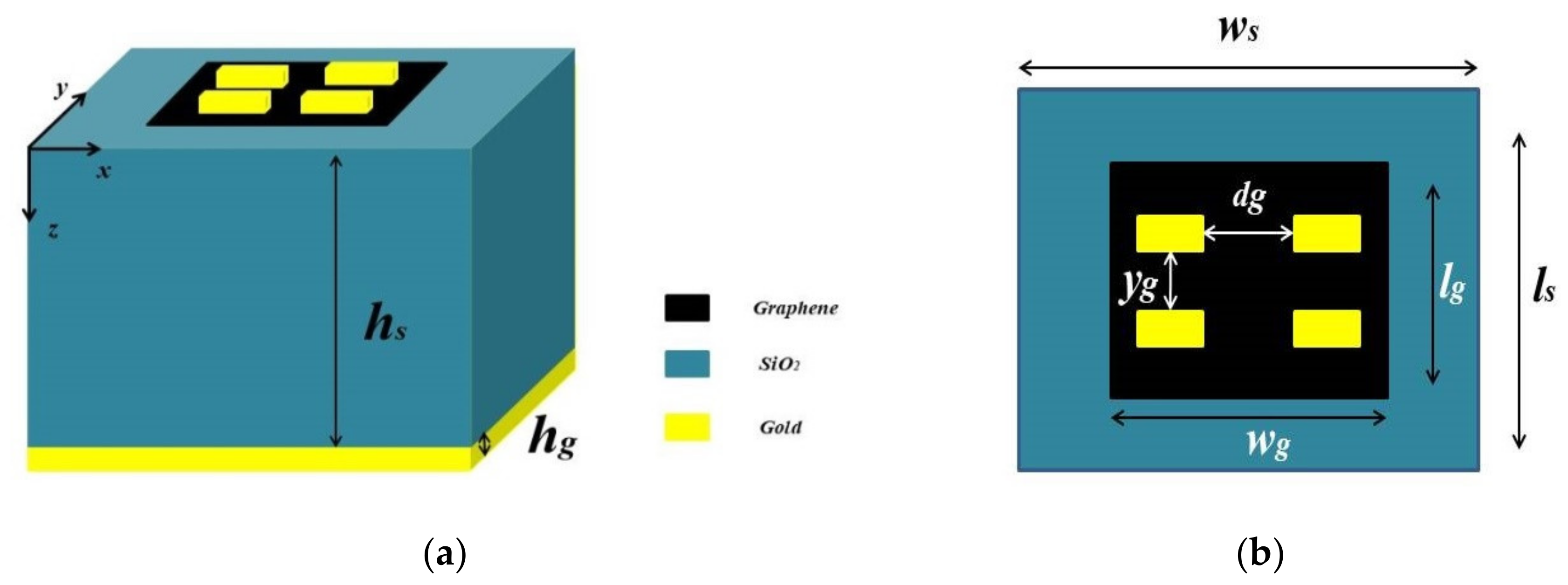


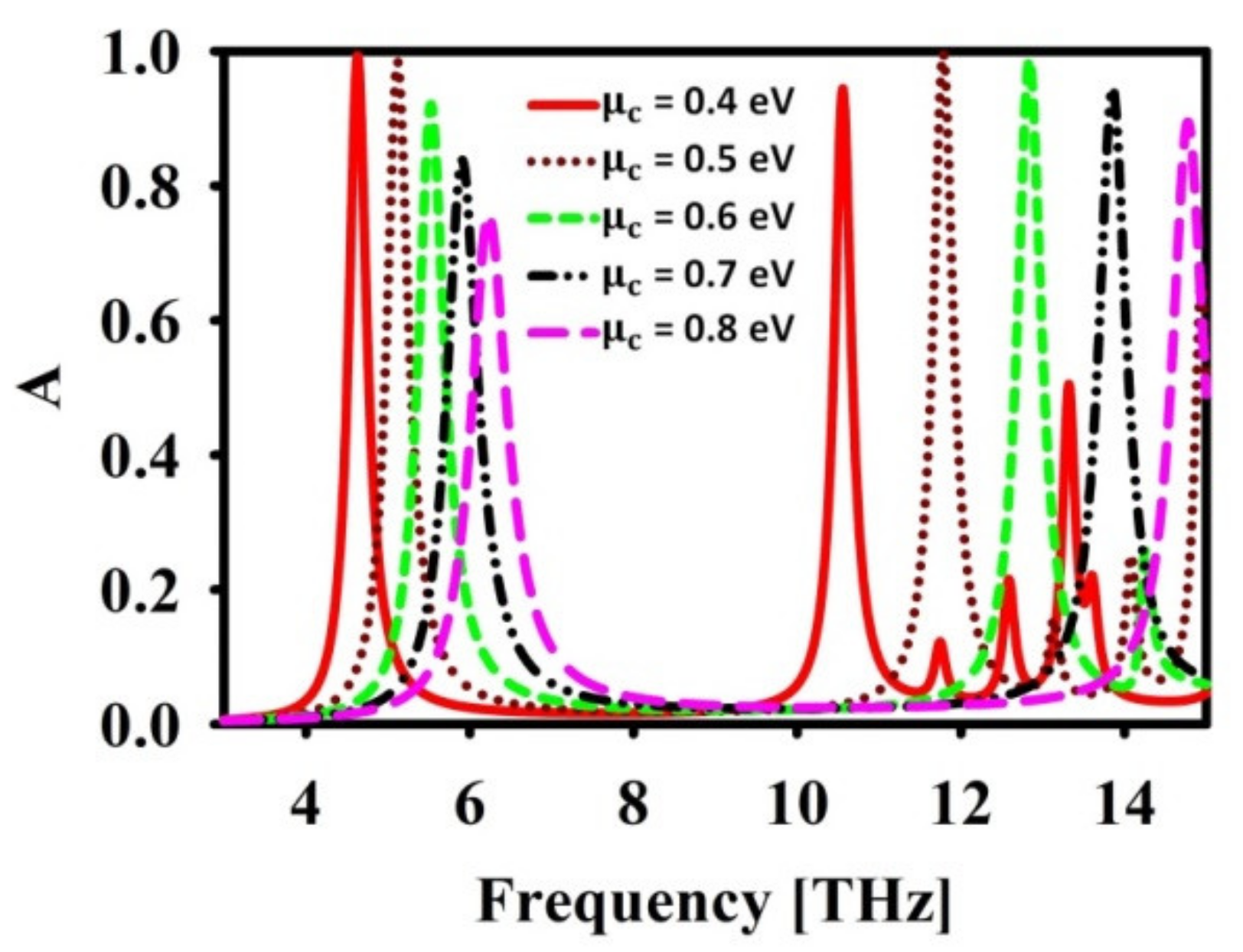
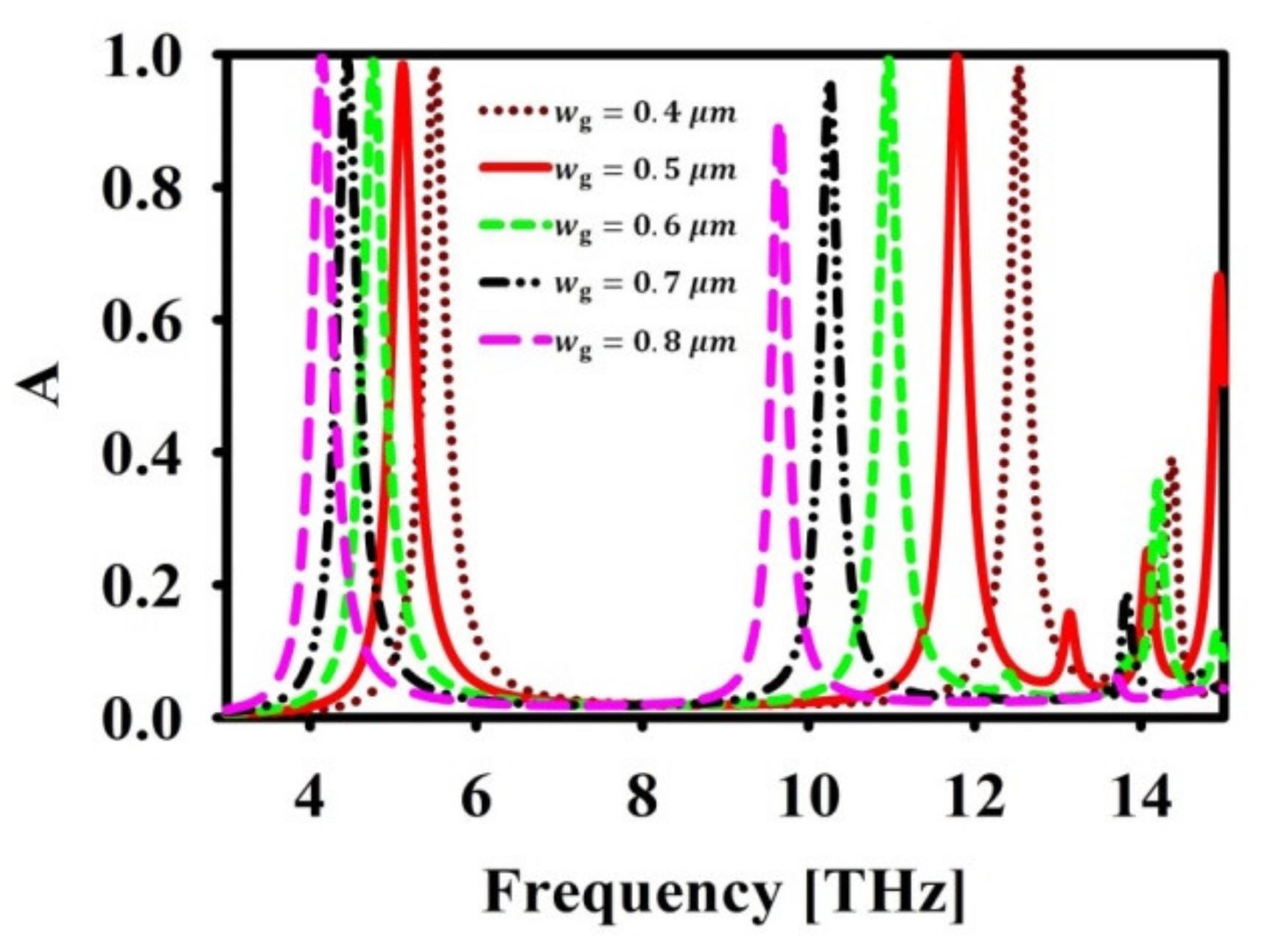
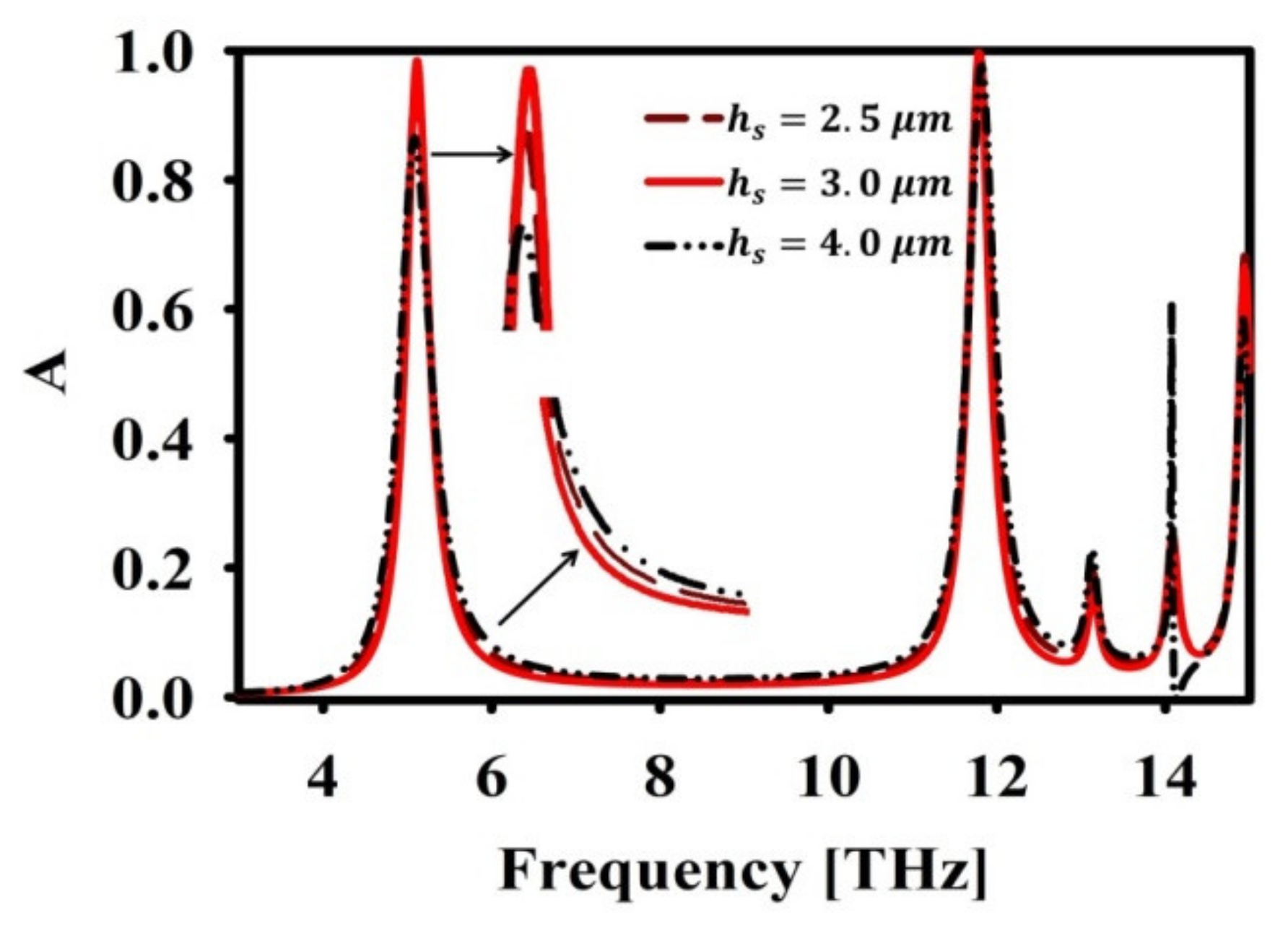

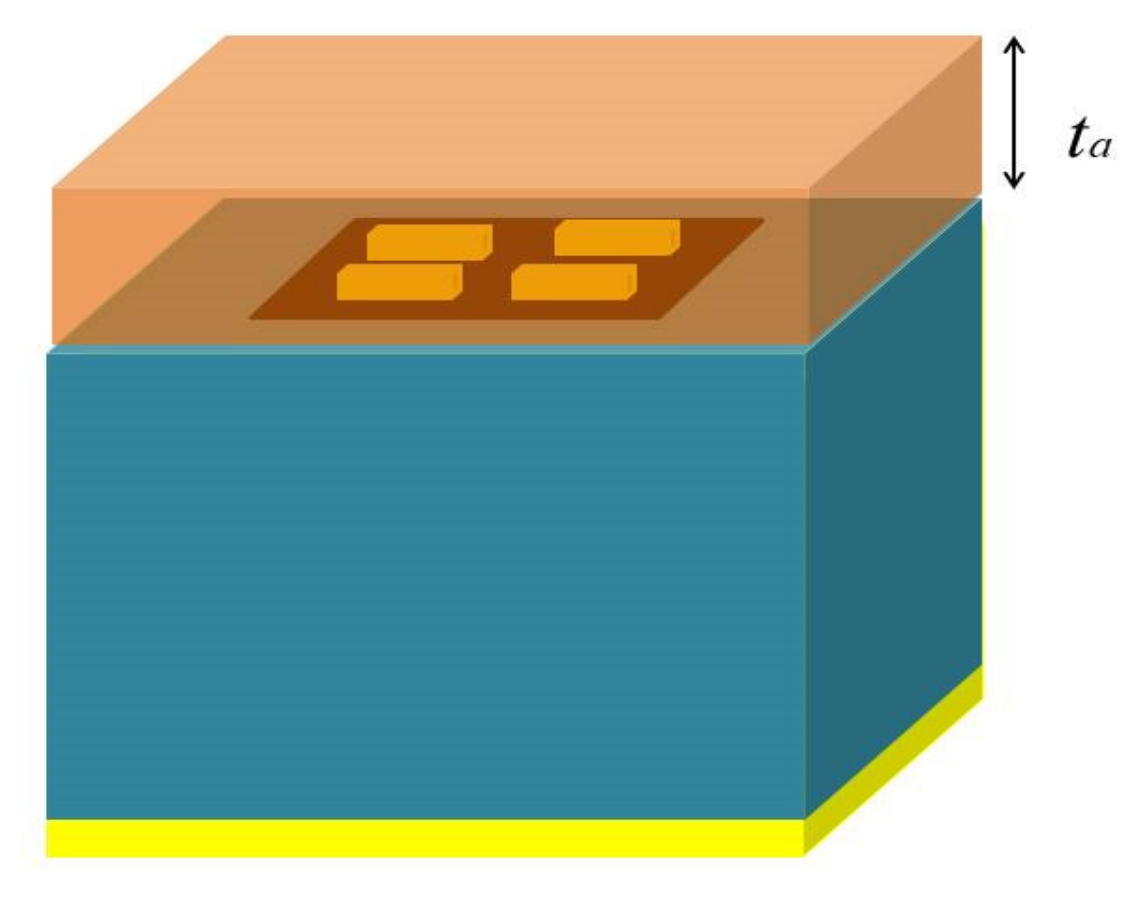

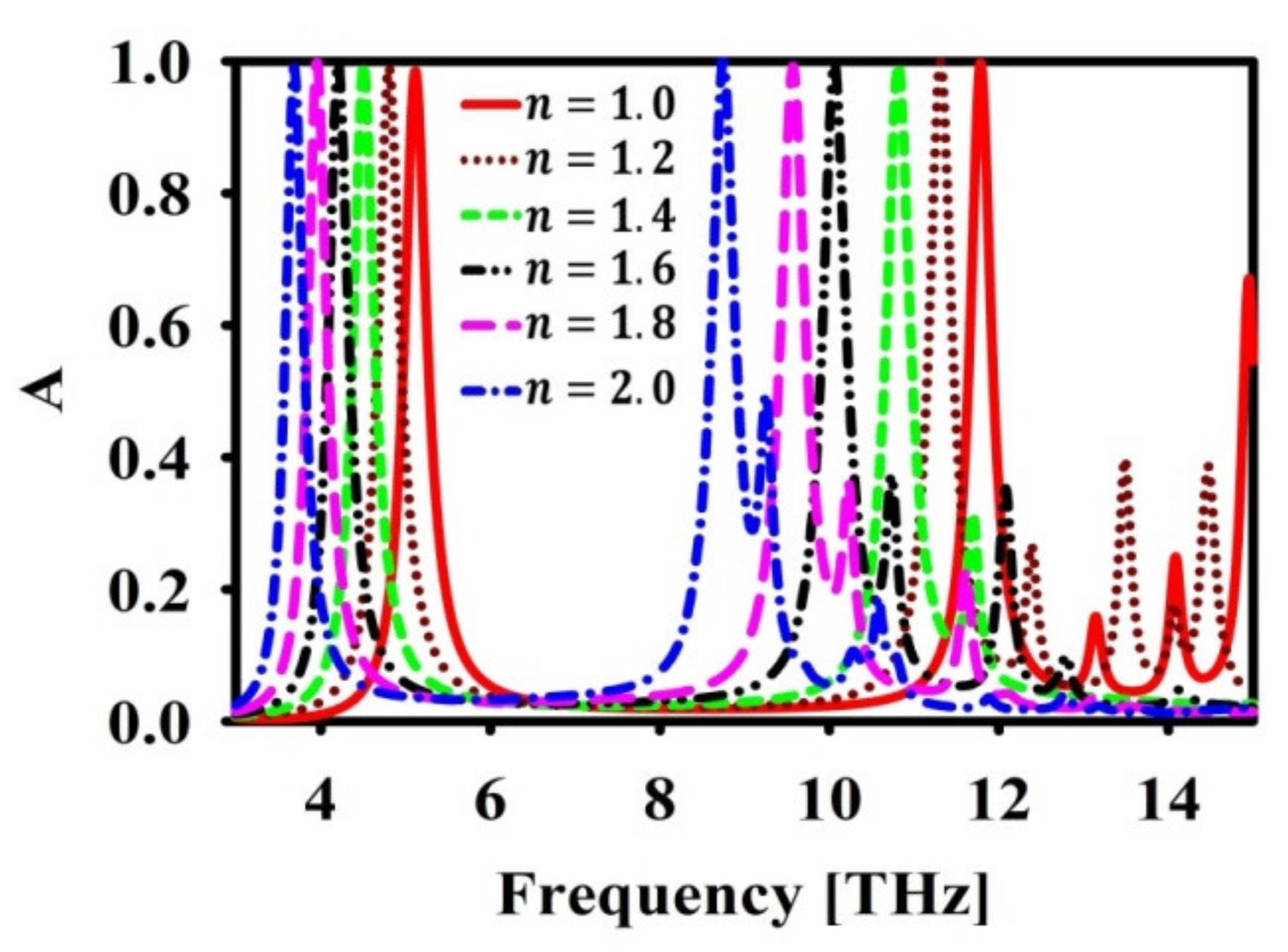
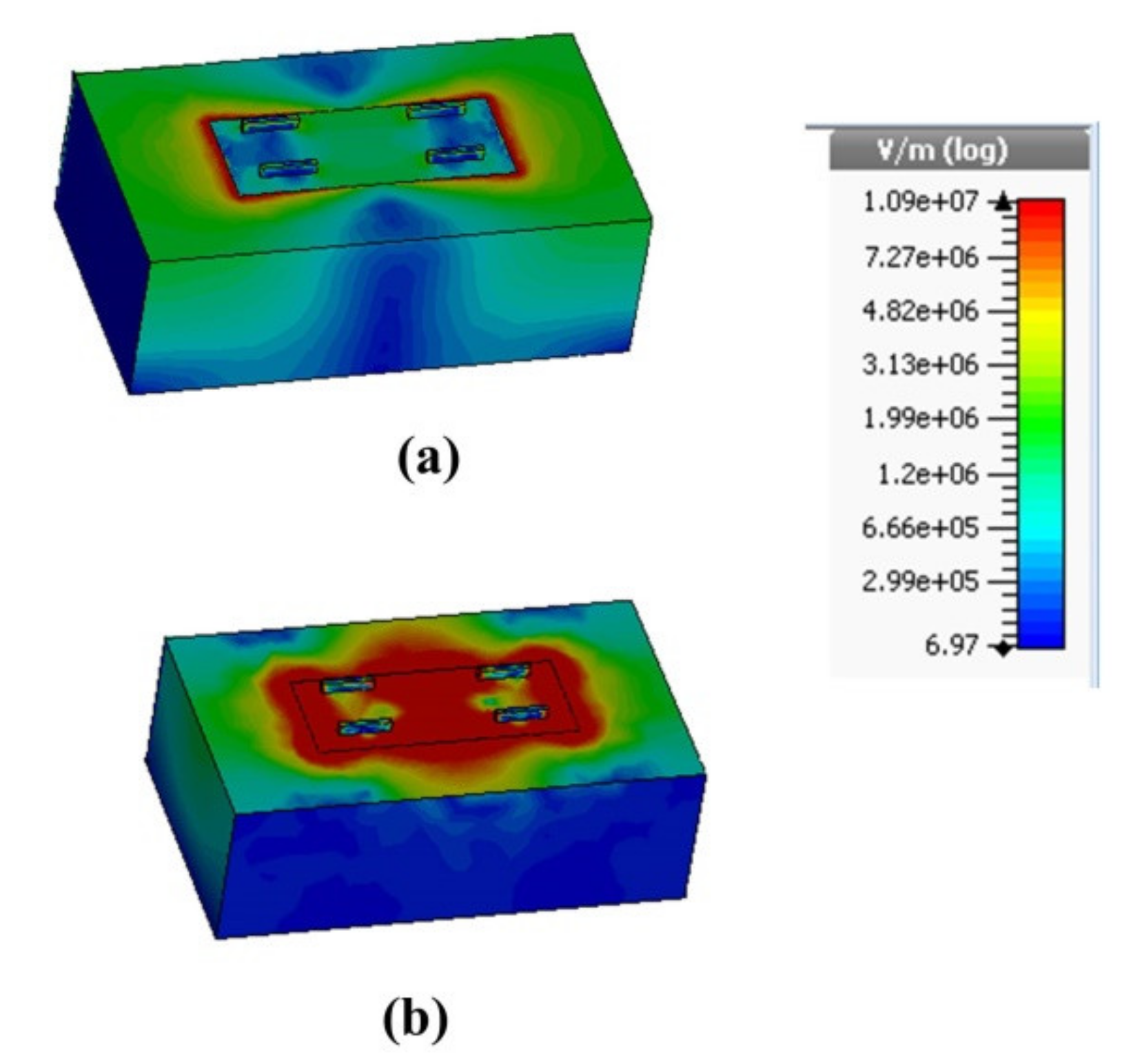
| Parameter | Value | Parameter | Value |
|---|---|---|---|
| 0.5 ev | |||
| FOM | |||||||
|---|---|---|---|---|---|---|---|
| Refractive index changes from nw = 1.3198 to ng = 1.3594 | I Resonant Peak | 0.0827 | 0.31 | 0.396 | 2.08 | 6.70 | 14 |
| II Resonant Peak | 0.187 | 0.34 | 0.396 | 4.72 | 13.88 | 32.49 | |
| Changes from 1.399 to | ||||||
|---|---|---|---|---|---|---|
| I Peak | II Peak | I Peak | II Peak | I Peak | II Peak | |
| 1.383 | 1.52 | 3.42 | 4.90 | 10.05 | 15.36 | 34.13 |
| 1.373 | 1.76 | 3.72 | 5.67 | 10.94 | 15.43 | 34.28 |
| Ref. | No of Bands | (I Peak, II Peak) | FOM | Tunablility | Polarization Insensitive upto the Angle in ° | Thickness in | |
|---|---|---|---|---|---|---|---|
| [27] | 1 | 0.16 | 62.82 | 3.82 | Yes | Not reported | 30 |
| [35] | 1 | 1.9 | 6.56 | 11.5 | Yes | Not reported | 1 |
| [45] | 1 | 0.13 | 1.04 | 3.7 | No | Not reported | 5 |
| [46] | 1 | 1.48 | 24.6 | 3 | No | Not reported | 10 |
| [25] | 1 | 4.7 | 13.84 | 5.71 | Yes | 70 | 3 |
| [43] | 2 | 0.22, 3.5 | 1.1, 7 | 0.71, 6.4 | No | Insensitive | 2 |
| [47] | 2 | 0.0001, – | – | 0.5, 1.425 | No | Not Reported | 642 |
| [48] | 2 | 0.1875, 0.360 | 7.2, 19.1 | 1.8, 2.26 | No | 30 | 8.6 |
| [49] | 2 | 0.147, 0.964 | 1.21, 17.28 | 1.08, 2.77 | No | Not Reported | 10.4 |
| [50] | 2 | 1.35, 2.95 | 4.67, 8.8 | 4.88, 10.9 | Yes | Insensitive | 2.52 |
| This work | 2 | 2.08 4.72 | 6.7, 13.88 | 5.1, 11.7 | Yes | 80 | 3 |
Publisher’s Note: MDPI stays neutral with regard to jurisdictional claims in published maps and institutional affiliations. |
© 2022 by the authors. Licensee MDPI, Basel, Switzerland. This article is an open access article distributed under the terms and conditions of the Creative Commons Attribution (CC BY) license (https://creativecommons.org/licenses/by/4.0/).
Share and Cite
Karthikeyan, M.; Jayabala, P.; Ramachandran, S.; Dhanabalan, S.S.; Sivanesan, T.; Ponnusamy, M. Tunable Optimal Dual Band Metamaterial Absorber for High Sensitivity THz Refractive Index Sensing. Nanomaterials 2022, 12, 2693. https://doi.org/10.3390/nano12152693
Karthikeyan M, Jayabala P, Ramachandran S, Dhanabalan SS, Sivanesan T, Ponnusamy M. Tunable Optimal Dual Band Metamaterial Absorber for High Sensitivity THz Refractive Index Sensing. Nanomaterials. 2022; 12(15):2693. https://doi.org/10.3390/nano12152693
Chicago/Turabian StyleKarthikeyan, Madurakavi, Pradeep Jayabala, Sitharthan Ramachandran, Shanmuga Sundar Dhanabalan, Thamizharasan Sivanesan, and Manimaran Ponnusamy. 2022. "Tunable Optimal Dual Band Metamaterial Absorber for High Sensitivity THz Refractive Index Sensing" Nanomaterials 12, no. 15: 2693. https://doi.org/10.3390/nano12152693
APA StyleKarthikeyan, M., Jayabala, P., Ramachandran, S., Dhanabalan, S. S., Sivanesan, T., & Ponnusamy, M. (2022). Tunable Optimal Dual Band Metamaterial Absorber for High Sensitivity THz Refractive Index Sensing. Nanomaterials, 12(15), 2693. https://doi.org/10.3390/nano12152693






